Association Between High Blood Pressure and Dementia Research Project
VerifiedAdded on 2020/01/23
|36
|8254
|124
Report
AI Summary
This research report investigates the correlation between high blood pressure and dementia, exploring the impact of hypertension on cognitive function and the development of dementia. The study utilizes qualitative research methods, including interviews with healthcare professionals, to analyze the causes, symptoms, and potential health implications of this relationship. The report includes a comprehensive literature review, examining existing research on the effects of high blood pressure on brain health and the various types of dementia, such as Alzheimer's and vascular dementia. The research also addresses the causes of dementia in adults over 40 and assesses the relationship between hypertension and dementia. The report concludes with recommendations for further study and potential preventative measures.
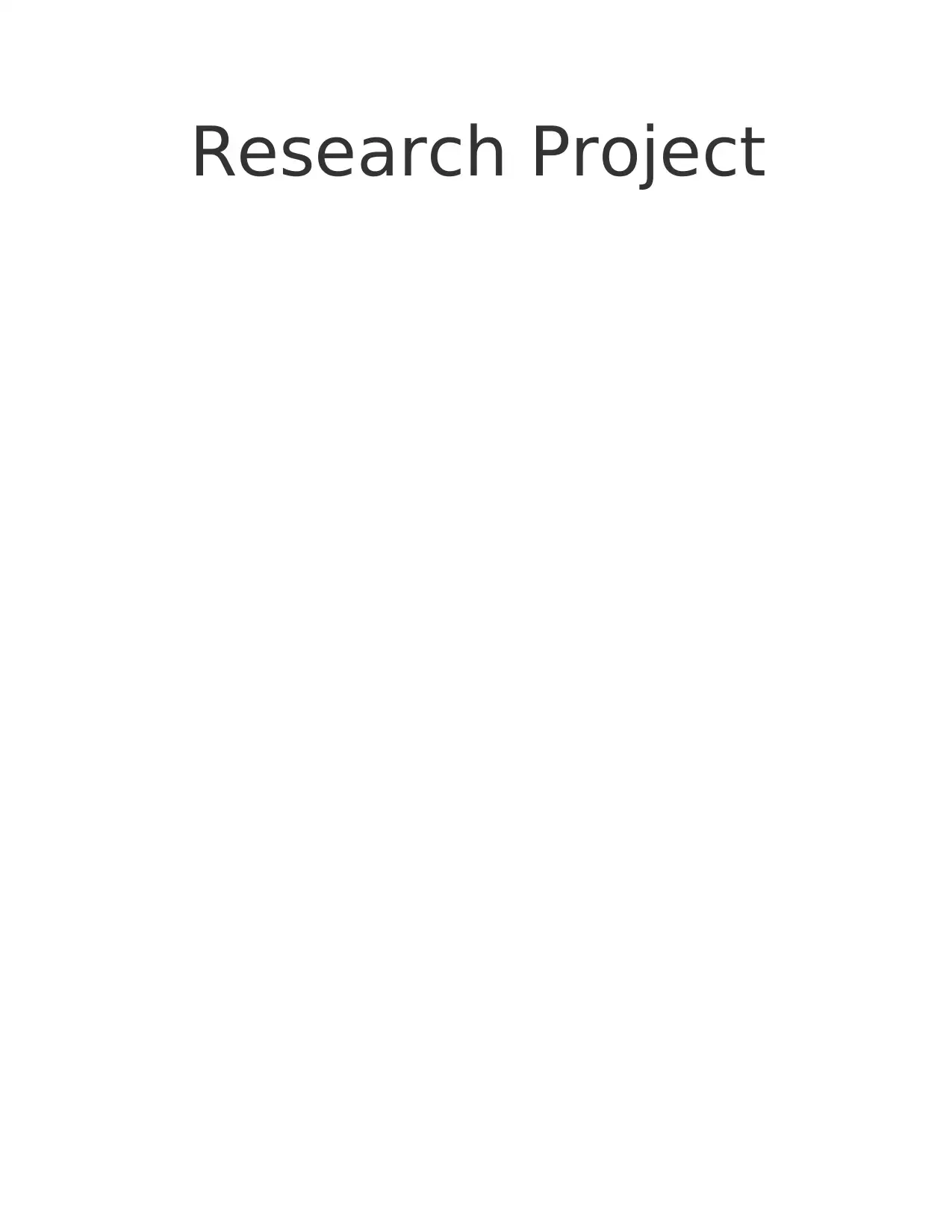
Research Project
Paraphrase This Document
Need a fresh take? Get an instant paraphrase of this document with our AI Paraphraser
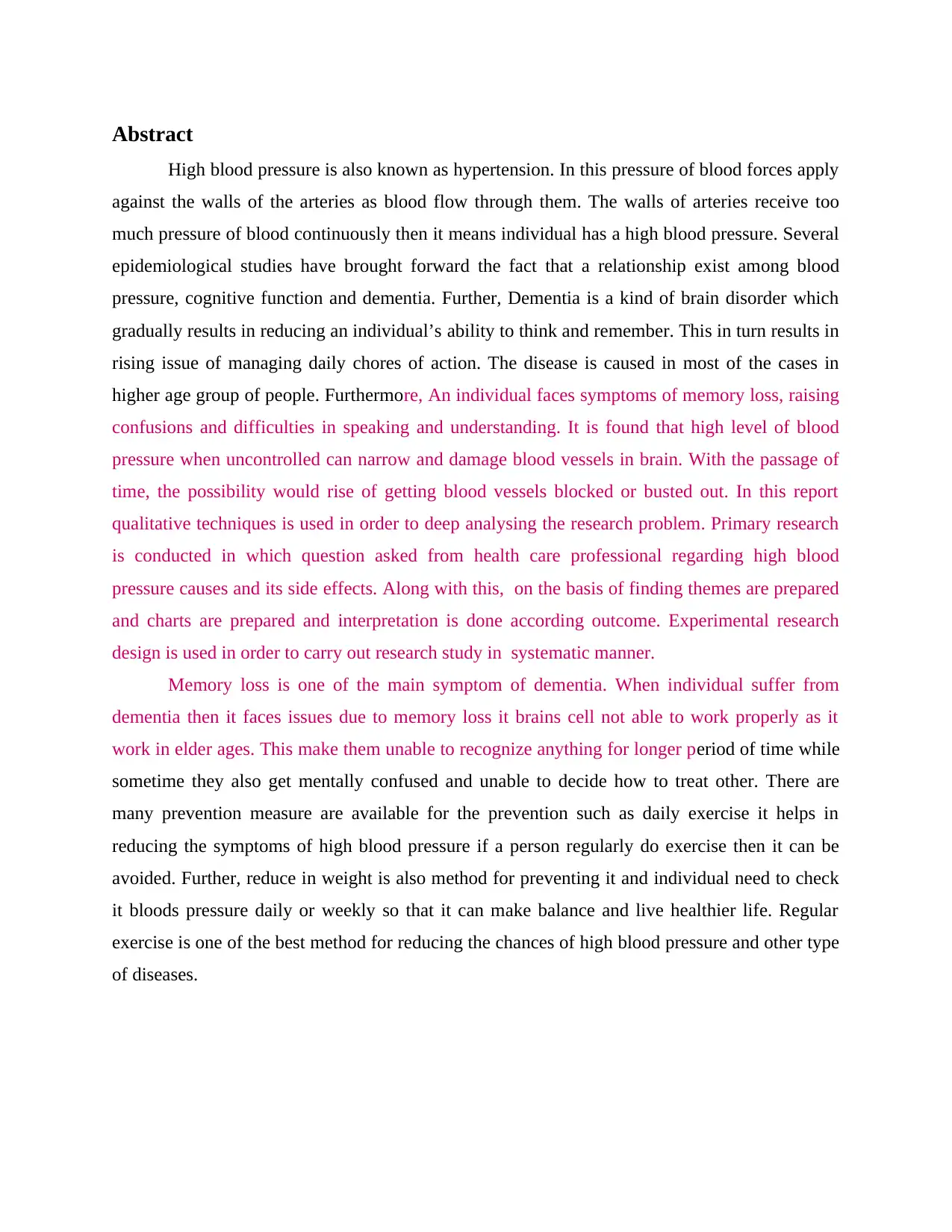
Abstract
High blood pressure is also known as hypertension. In this pressure of blood forces apply
against the walls of the arteries as blood flow through them. The walls of arteries receive too
much pressure of blood continuously then it means individual has a high blood pressure. Several
epidemiological studies have brought forward the fact that a relationship exist among blood
pressure, cognitive function and dementia. Further, Dementia is a kind of brain disorder which
gradually results in reducing an individual’s ability to think and remember. This in turn results in
rising issue of managing daily chores of action. The disease is caused in most of the cases in
higher age group of people. Furthermore, An individual faces symptoms of memory loss, raising
confusions and difficulties in speaking and understanding. It is found that high level of blood
pressure when uncontrolled can narrow and damage blood vessels in brain. With the passage of
time, the possibility would rise of getting blood vessels blocked or busted out. In this report
qualitative techniques is used in order to deep analysing the research problem. Primary research
is conducted in which question asked from health care professional regarding high blood
pressure causes and its side effects. Along with this, on the basis of finding themes are prepared
and charts are prepared and interpretation is done according outcome. Experimental research
design is used in order to carry out research study in systematic manner.
Memory loss is one of the main symptom of dementia. When individual suffer from
dementia then it faces issues due to memory loss it brains cell not able to work properly as it
work in elder ages. This make them unable to recognize anything for longer period of time while
sometime they also get mentally confused and unable to decide how to treat other. There are
many prevention measure are available for the prevention such as daily exercise it helps in
reducing the symptoms of high blood pressure if a person regularly do exercise then it can be
avoided. Further, reduce in weight is also method for preventing it and individual need to check
it bloods pressure daily or weekly so that it can make balance and live healthier life. Regular
exercise is one of the best method for reducing the chances of high blood pressure and other type
of diseases.
High blood pressure is also known as hypertension. In this pressure of blood forces apply
against the walls of the arteries as blood flow through them. The walls of arteries receive too
much pressure of blood continuously then it means individual has a high blood pressure. Several
epidemiological studies have brought forward the fact that a relationship exist among blood
pressure, cognitive function and dementia. Further, Dementia is a kind of brain disorder which
gradually results in reducing an individual’s ability to think and remember. This in turn results in
rising issue of managing daily chores of action. The disease is caused in most of the cases in
higher age group of people. Furthermore, An individual faces symptoms of memory loss, raising
confusions and difficulties in speaking and understanding. It is found that high level of blood
pressure when uncontrolled can narrow and damage blood vessels in brain. With the passage of
time, the possibility would rise of getting blood vessels blocked or busted out. In this report
qualitative techniques is used in order to deep analysing the research problem. Primary research
is conducted in which question asked from health care professional regarding high blood
pressure causes and its side effects. Along with this, on the basis of finding themes are prepared
and charts are prepared and interpretation is done according outcome. Experimental research
design is used in order to carry out research study in systematic manner.
Memory loss is one of the main symptom of dementia. When individual suffer from
dementia then it faces issues due to memory loss it brains cell not able to work properly as it
work in elder ages. This make them unable to recognize anything for longer period of time while
sometime they also get mentally confused and unable to decide how to treat other. There are
many prevention measure are available for the prevention such as daily exercise it helps in
reducing the symptoms of high blood pressure if a person regularly do exercise then it can be
avoided. Further, reduce in weight is also method for preventing it and individual need to check
it bloods pressure daily or weekly so that it can make balance and live healthier life. Regular
exercise is one of the best method for reducing the chances of high blood pressure and other type
of diseases.
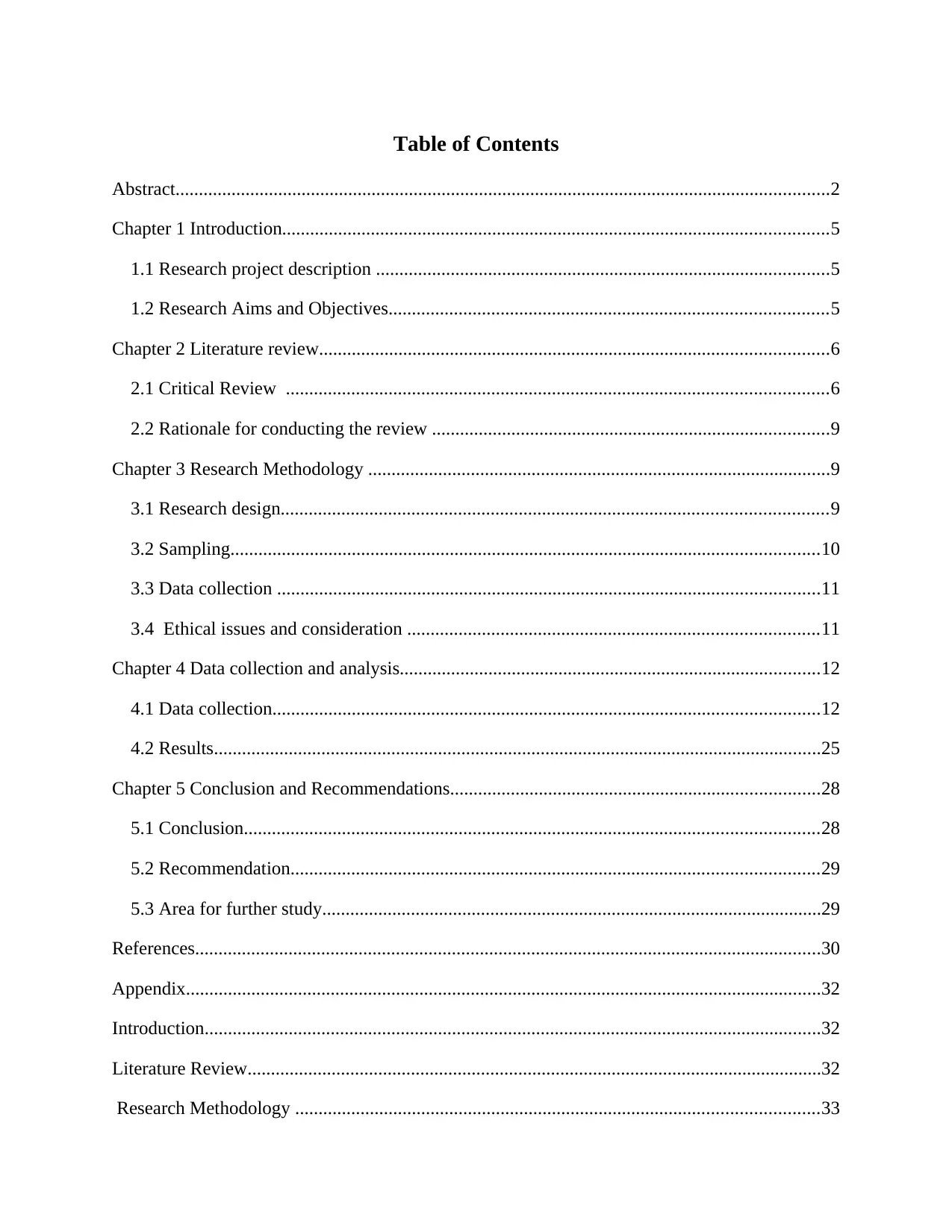
Table of Contents
Abstract............................................................................................................................................2
Chapter 1 Introduction.....................................................................................................................5
1.1 Research project description .................................................................................................5
1.2 Research Aims and Objectives..............................................................................................5
Chapter 2 Literature review.............................................................................................................6
2.1 Critical Review ....................................................................................................................6
2.2 Rationale for conducting the review .....................................................................................9
Chapter 3 Research Methodology ...................................................................................................9
3.1 Research design.....................................................................................................................9
3.2 Sampling..............................................................................................................................10
3.3 Data collection ....................................................................................................................11
3.4 Ethical issues and consideration ........................................................................................11
Chapter 4 Data collection and analysis..........................................................................................12
4.1 Data collection.....................................................................................................................12
4.2 Results..................................................................................................................................25
Chapter 5 Conclusion and Recommendations...............................................................................28
5.1 Conclusion...........................................................................................................................28
5.2 Recommendation.................................................................................................................29
5.3 Area for further study...........................................................................................................29
References......................................................................................................................................30
Appendix........................................................................................................................................32
Introduction....................................................................................................................................32
Literature Review...........................................................................................................................32
Research Methodology ................................................................................................................33
Abstract............................................................................................................................................2
Chapter 1 Introduction.....................................................................................................................5
1.1 Research project description .................................................................................................5
1.2 Research Aims and Objectives..............................................................................................5
Chapter 2 Literature review.............................................................................................................6
2.1 Critical Review ....................................................................................................................6
2.2 Rationale for conducting the review .....................................................................................9
Chapter 3 Research Methodology ...................................................................................................9
3.1 Research design.....................................................................................................................9
3.2 Sampling..............................................................................................................................10
3.3 Data collection ....................................................................................................................11
3.4 Ethical issues and consideration ........................................................................................11
Chapter 4 Data collection and analysis..........................................................................................12
4.1 Data collection.....................................................................................................................12
4.2 Results..................................................................................................................................25
Chapter 5 Conclusion and Recommendations...............................................................................28
5.1 Conclusion...........................................................................................................................28
5.2 Recommendation.................................................................................................................29
5.3 Area for further study...........................................................................................................29
References......................................................................................................................................30
Appendix........................................................................................................................................32
Introduction....................................................................................................................................32
Literature Review...........................................................................................................................32
Research Methodology ................................................................................................................33
⊘ This is a preview!⊘
Do you want full access?
Subscribe today to unlock all pages.

Trusted by 1+ million students worldwide

Gantt chart......................................................................................................................................34
Paraphrase This Document
Need a fresh take? Get an instant paraphrase of this document with our AI Paraphraser
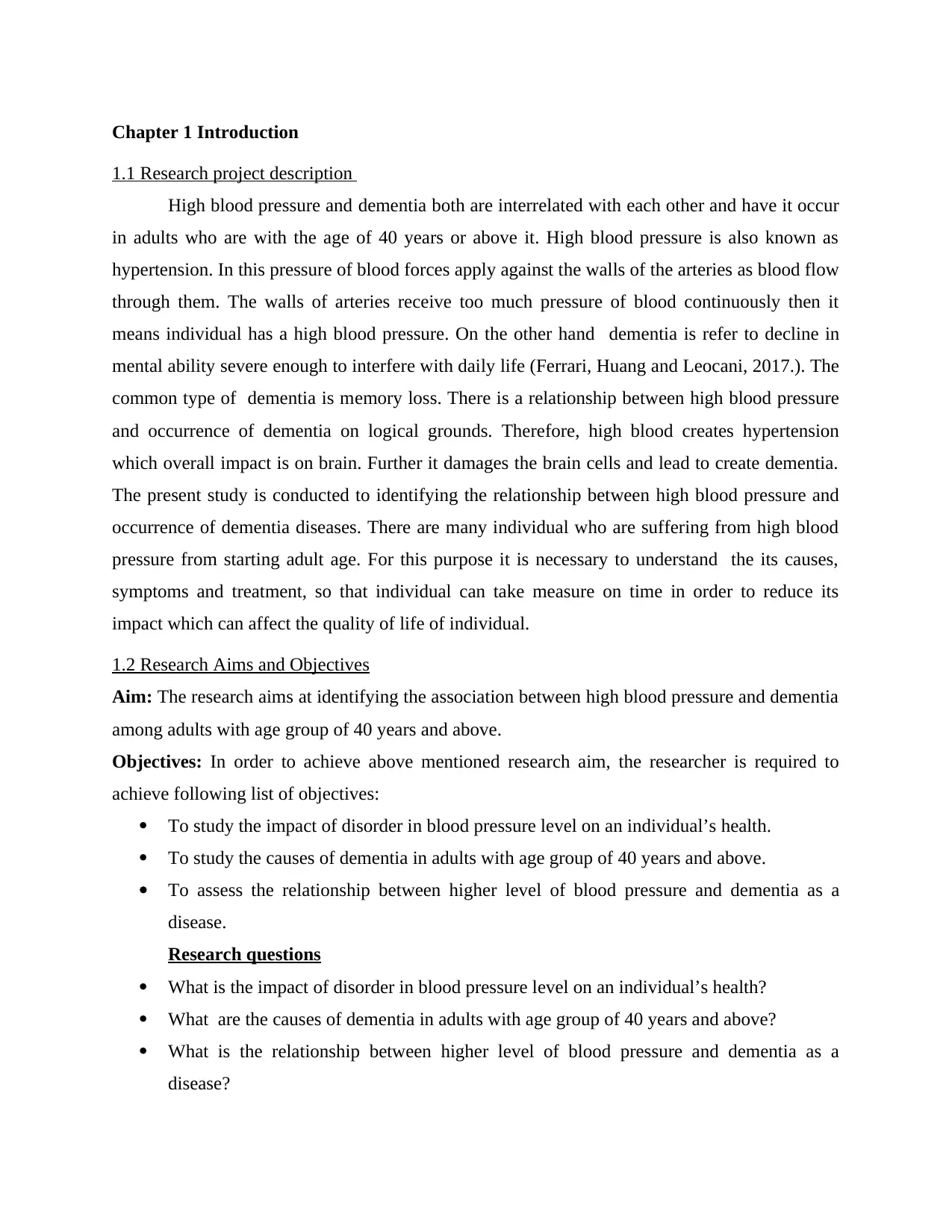
Chapter 1 Introduction
1.1 Research project description
High blood pressure and dementia both are interrelated with each other and have it occur
in adults who are with the age of 40 years or above it. High blood pressure is also known as
hypertension. In this pressure of blood forces apply against the walls of the arteries as blood flow
through them. The walls of arteries receive too much pressure of blood continuously then it
means individual has a high blood pressure. On the other hand dementia is refer to decline in
mental ability severe enough to interfere with daily life (Ferrari, Huang and Leocani, 2017.). The
common type of dementia is memory loss. There is a relationship between high blood pressure
and occurrence of dementia on logical grounds. Therefore, high blood creates hypertension
which overall impact is on brain. Further it damages the brain cells and lead to create dementia.
The present study is conducted to identifying the relationship between high blood pressure and
occurrence of dementia diseases. There are many individual who are suffering from high blood
pressure from starting adult age. For this purpose it is necessary to understand the its causes,
symptoms and treatment, so that individual can take measure on time in order to reduce its
impact which can affect the quality of life of individual.
1.2 Research Aims and Objectives
Aim: The research aims at identifying the association between high blood pressure and dementia
among adults with age group of 40 years and above.
Objectives: In order to achieve above mentioned research aim, the researcher is required to
achieve following list of objectives:
To study the impact of disorder in blood pressure level on an individual’s health.
To study the causes of dementia in adults with age group of 40 years and above.
To assess the relationship between higher level of blood pressure and dementia as a
disease.
Research questions
What is the impact of disorder in blood pressure level on an individual’s health?
What are the causes of dementia in adults with age group of 40 years and above?
What is the relationship between higher level of blood pressure and dementia as a
disease?
1.1 Research project description
High blood pressure and dementia both are interrelated with each other and have it occur
in adults who are with the age of 40 years or above it. High blood pressure is also known as
hypertension. In this pressure of blood forces apply against the walls of the arteries as blood flow
through them. The walls of arteries receive too much pressure of blood continuously then it
means individual has a high blood pressure. On the other hand dementia is refer to decline in
mental ability severe enough to interfere with daily life (Ferrari, Huang and Leocani, 2017.). The
common type of dementia is memory loss. There is a relationship between high blood pressure
and occurrence of dementia on logical grounds. Therefore, high blood creates hypertension
which overall impact is on brain. Further it damages the brain cells and lead to create dementia.
The present study is conducted to identifying the relationship between high blood pressure and
occurrence of dementia diseases. There are many individual who are suffering from high blood
pressure from starting adult age. For this purpose it is necessary to understand the its causes,
symptoms and treatment, so that individual can take measure on time in order to reduce its
impact which can affect the quality of life of individual.
1.2 Research Aims and Objectives
Aim: The research aims at identifying the association between high blood pressure and dementia
among adults with age group of 40 years and above.
Objectives: In order to achieve above mentioned research aim, the researcher is required to
achieve following list of objectives:
To study the impact of disorder in blood pressure level on an individual’s health.
To study the causes of dementia in adults with age group of 40 years and above.
To assess the relationship between higher level of blood pressure and dementia as a
disease.
Research questions
What is the impact of disorder in blood pressure level on an individual’s health?
What are the causes of dementia in adults with age group of 40 years and above?
What is the relationship between higher level of blood pressure and dementia as a
disease?
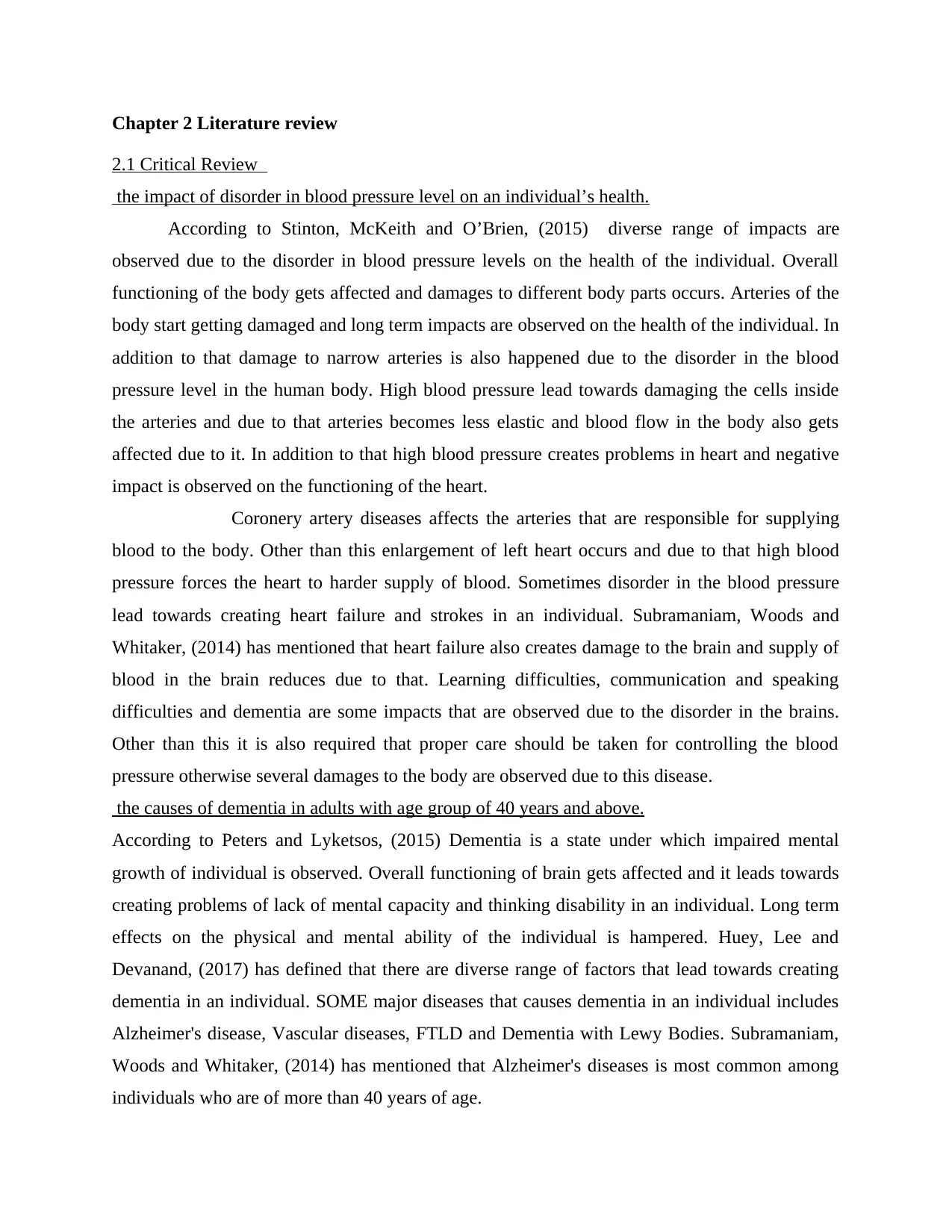
Chapter 2 Literature review
2.1 Critical Review
the impact of disorder in blood pressure level on an individual’s health.
According to Stinton, McKeith and O’Brien, (2015) diverse range of impacts are
observed due to the disorder in blood pressure levels on the health of the individual. Overall
functioning of the body gets affected and damages to different body parts occurs. Arteries of the
body start getting damaged and long term impacts are observed on the health of the individual. In
addition to that damage to narrow arteries is also happened due to the disorder in the blood
pressure level in the human body. High blood pressure lead towards damaging the cells inside
the arteries and due to that arteries becomes less elastic and blood flow in the body also gets
affected due to it. In addition to that high blood pressure creates problems in heart and negative
impact is observed on the functioning of the heart.
Coronery artery diseases affects the arteries that are responsible for supplying
blood to the body. Other than this enlargement of left heart occurs and due to that high blood
pressure forces the heart to harder supply of blood. Sometimes disorder in the blood pressure
lead towards creating heart failure and strokes in an individual. Subramaniam, Woods and
Whitaker, (2014) has mentioned that heart failure also creates damage to the brain and supply of
blood in the brain reduces due to that. Learning difficulties, communication and speaking
difficulties and dementia are some impacts that are observed due to the disorder in the brains.
Other than this it is also required that proper care should be taken for controlling the blood
pressure otherwise several damages to the body are observed due to this disease.
the causes of dementia in adults with age group of 40 years and above.
According to Peters and Lyketsos, (2015) Dementia is a state under which impaired mental
growth of individual is observed. Overall functioning of brain gets affected and it leads towards
creating problems of lack of mental capacity and thinking disability in an individual. Long term
effects on the physical and mental ability of the individual is hampered. Huey, Lee and
Devanand, (2017) has defined that there are diverse range of factors that lead towards creating
dementia in an individual. SOME major diseases that causes dementia in an individual includes
Alzheimer's disease, Vascular diseases, FTLD and Dementia with Lewy Bodies. Subramaniam,
Woods and Whitaker, (2014) has mentioned that Alzheimer's diseases is most common among
individuals who are of more than 40 years of age.
2.1 Critical Review
the impact of disorder in blood pressure level on an individual’s health.
According to Stinton, McKeith and O’Brien, (2015) diverse range of impacts are
observed due to the disorder in blood pressure levels on the health of the individual. Overall
functioning of the body gets affected and damages to different body parts occurs. Arteries of the
body start getting damaged and long term impacts are observed on the health of the individual. In
addition to that damage to narrow arteries is also happened due to the disorder in the blood
pressure level in the human body. High blood pressure lead towards damaging the cells inside
the arteries and due to that arteries becomes less elastic and blood flow in the body also gets
affected due to it. In addition to that high blood pressure creates problems in heart and negative
impact is observed on the functioning of the heart.
Coronery artery diseases affects the arteries that are responsible for supplying
blood to the body. Other than this enlargement of left heart occurs and due to that high blood
pressure forces the heart to harder supply of blood. Sometimes disorder in the blood pressure
lead towards creating heart failure and strokes in an individual. Subramaniam, Woods and
Whitaker, (2014) has mentioned that heart failure also creates damage to the brain and supply of
blood in the brain reduces due to that. Learning difficulties, communication and speaking
difficulties and dementia are some impacts that are observed due to the disorder in the brains.
Other than this it is also required that proper care should be taken for controlling the blood
pressure otherwise several damages to the body are observed due to this disease.
the causes of dementia in adults with age group of 40 years and above.
According to Peters and Lyketsos, (2015) Dementia is a state under which impaired mental
growth of individual is observed. Overall functioning of brain gets affected and it leads towards
creating problems of lack of mental capacity and thinking disability in an individual. Long term
effects on the physical and mental ability of the individual is hampered. Huey, Lee and
Devanand, (2017) has defined that there are diverse range of factors that lead towards creating
dementia in an individual. SOME major diseases that causes dementia in an individual includes
Alzheimer's disease, Vascular diseases, FTLD and Dementia with Lewy Bodies. Subramaniam,
Woods and Whitaker, (2014) has mentioned that Alzheimer's diseases is most common among
individuals who are of more than 40 years of age.
⊘ This is a preview!⊘
Do you want full access?
Subscribe today to unlock all pages.

Trusted by 1+ million students worldwide
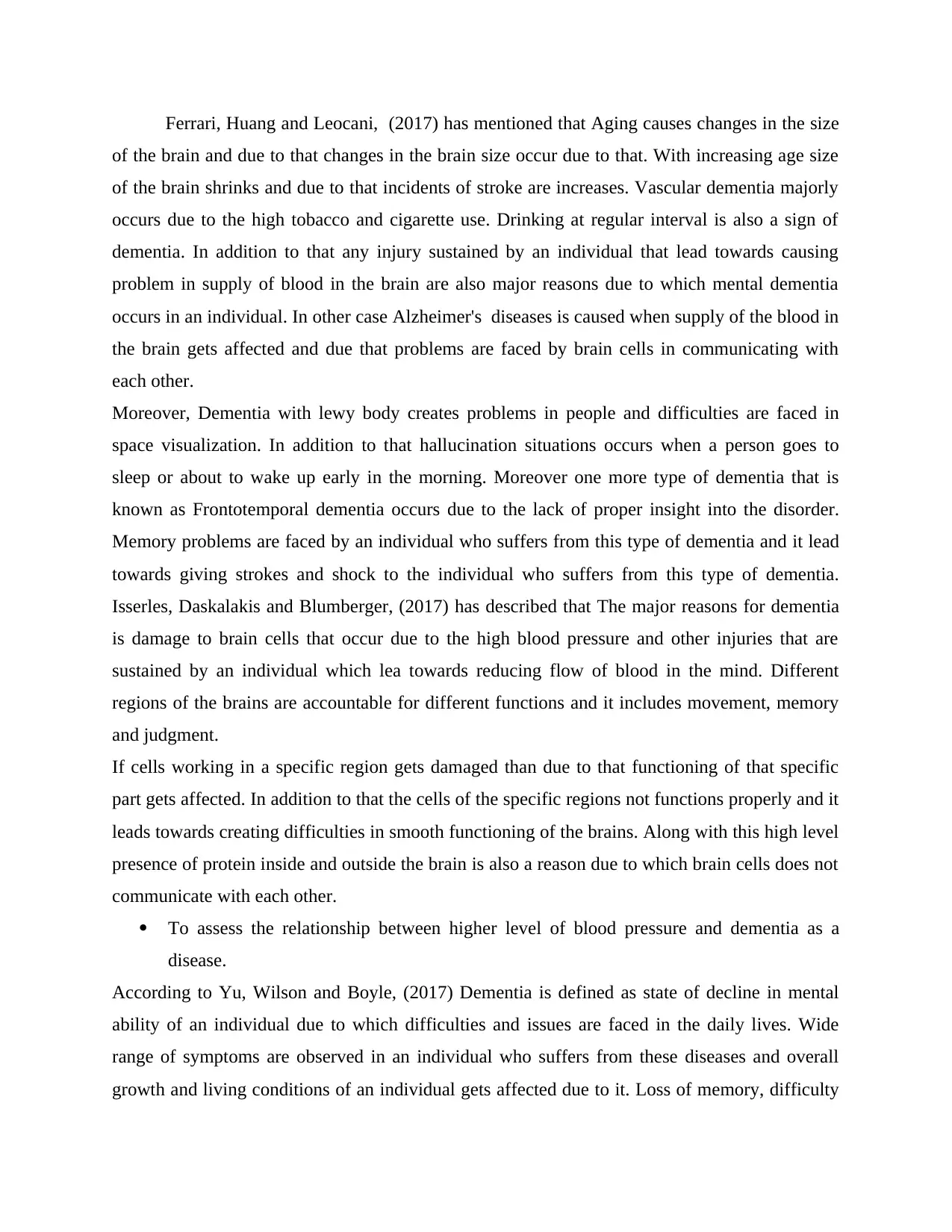
Ferrari, Huang and Leocani, (2017) has mentioned that Aging causes changes in the size
of the brain and due to that changes in the brain size occur due to that. With increasing age size
of the brain shrinks and due to that incidents of stroke are increases. Vascular dementia majorly
occurs due to the high tobacco and cigarette use. Drinking at regular interval is also a sign of
dementia. In addition to that any injury sustained by an individual that lead towards causing
problem in supply of blood in the brain are also major reasons due to which mental dementia
occurs in an individual. In other case Alzheimer's diseases is caused when supply of the blood in
the brain gets affected and due that problems are faced by brain cells in communicating with
each other.
Moreover, Dementia with lewy body creates problems in people and difficulties are faced in
space visualization. In addition to that hallucination situations occurs when a person goes to
sleep or about to wake up early in the morning. Moreover one more type of dementia that is
known as Frontotemporal dementia occurs due to the lack of proper insight into the disorder.
Memory problems are faced by an individual who suffers from this type of dementia and it lead
towards giving strokes and shock to the individual who suffers from this type of dementia.
Isserles, Daskalakis and Blumberger, (2017) has described that The major reasons for dementia
is damage to brain cells that occur due to the high blood pressure and other injuries that are
sustained by an individual which lea towards reducing flow of blood in the mind. Different
regions of the brains are accountable for different functions and it includes movement, memory
and judgment.
If cells working in a specific region gets damaged than due to that functioning of that specific
part gets affected. In addition to that the cells of the specific regions not functions properly and it
leads towards creating difficulties in smooth functioning of the brains. Along with this high level
presence of protein inside and outside the brain is also a reason due to which brain cells does not
communicate with each other.
To assess the relationship between higher level of blood pressure and dementia as a
disease.
According to Yu, Wilson and Boyle, (2017) Dementia is defined as state of decline in mental
ability of an individual due to which difficulties and issues are faced in the daily lives. Wide
range of symptoms are observed in an individual who suffers from these diseases and overall
growth and living conditions of an individual gets affected due to it. Loss of memory, difficulty
of the brain and due to that changes in the brain size occur due to that. With increasing age size
of the brain shrinks and due to that incidents of stroke are increases. Vascular dementia majorly
occurs due to the high tobacco and cigarette use. Drinking at regular interval is also a sign of
dementia. In addition to that any injury sustained by an individual that lead towards causing
problem in supply of blood in the brain are also major reasons due to which mental dementia
occurs in an individual. In other case Alzheimer's diseases is caused when supply of the blood in
the brain gets affected and due that problems are faced by brain cells in communicating with
each other.
Moreover, Dementia with lewy body creates problems in people and difficulties are faced in
space visualization. In addition to that hallucination situations occurs when a person goes to
sleep or about to wake up early in the morning. Moreover one more type of dementia that is
known as Frontotemporal dementia occurs due to the lack of proper insight into the disorder.
Memory problems are faced by an individual who suffers from this type of dementia and it lead
towards giving strokes and shock to the individual who suffers from this type of dementia.
Isserles, Daskalakis and Blumberger, (2017) has described that The major reasons for dementia
is damage to brain cells that occur due to the high blood pressure and other injuries that are
sustained by an individual which lea towards reducing flow of blood in the mind. Different
regions of the brains are accountable for different functions and it includes movement, memory
and judgment.
If cells working in a specific region gets damaged than due to that functioning of that specific
part gets affected. In addition to that the cells of the specific regions not functions properly and it
leads towards creating difficulties in smooth functioning of the brains. Along with this high level
presence of protein inside and outside the brain is also a reason due to which brain cells does not
communicate with each other.
To assess the relationship between higher level of blood pressure and dementia as a
disease.
According to Yu, Wilson and Boyle, (2017) Dementia is defined as state of decline in mental
ability of an individual due to which difficulties and issues are faced in the daily lives. Wide
range of symptoms are observed in an individual who suffers from these diseases and overall
growth and living conditions of an individual gets affected due to it. Loss of memory, difficulty
Paraphrase This Document
Need a fresh take? Get an instant paraphrase of this document with our AI Paraphraser

in communication and languages and lack in ability of focus and pay attention are faced in this
disease. Moreover, this diseases mainly occur when brain cells does not communicate well in
normal mode. It leads towards creating difficulty for the individual to think and behave in normal
mode. Isserles, Daskalakis and Blumberger, (2017) has described that there is direct relationship
between higher level of blood pressure and dementia as diseases.
High blood pressure creates hypertension in an individual and due to that overall impact is being
observed on the normal functioning of an individual. High blood pressure creates damage to
brain cells and lead towards creating severe diseases in an individual such as dementia and other
mental diseases. Ferrari, Huang and Leocani, (2017) has described that proper blood supply in
the brain is essential so that smooth functioning of brain cells can be ensured. When brain cells
of an individual does not work properly than due to that difficulty are faced in thinking,
speaking, reasoning and vision movement.
There are different types of dementia that occur and one most common is Vascular dementia in
which narrowing and blockage of arteries lead towards creating difficulties in supply of blood in
the brain. In addition to that uncontrolled blood pressure lead towards creating damaging and
weakening of the blood vessels and blood flow in the arteries reduces due to it. If interruption
occur than due to that chances of occurring dementia in an individual increases. Bertoux and
Hornberger, (2016) has explained that high blood pressure lead towards increasing probability
for creating dementia in an individual. If good vascular health is maintained by the person than
chances of creating dementia reduces and fewer problems are faced by the person. It is vital that
focus should be given for maintaining good health conditions so that risk of dementia reduces.
Risk of vascular dementia increases and due to that more problems are faced by an individual.
Moreover memory loss, problems in logical thinking and difficulties in understanding and
speaking are faced. Other than this dementia also causes loss in memory and some other mental
related issues are also faced. Vascular dementia also creates problems and cells in the brain also
gets affected. In addition to that a person suffering from vascular dementia faces problems in
communication, speaking and listening in proper manner.
Huey, Lee and Devanand, (2017) has mentioned that High blood pressure creates problems in the
blood circulation system and overall functioning of the brain gets affected due to it. Proper flow
of blood in the system reduces and blood system that supplies blood faces difficulty in that. If
there are blocks that occur in the blood vessels than due to that difficulties are faced in the flow
disease. Moreover, this diseases mainly occur when brain cells does not communicate well in
normal mode. It leads towards creating difficulty for the individual to think and behave in normal
mode. Isserles, Daskalakis and Blumberger, (2017) has described that there is direct relationship
between higher level of blood pressure and dementia as diseases.
High blood pressure creates hypertension in an individual and due to that overall impact is being
observed on the normal functioning of an individual. High blood pressure creates damage to
brain cells and lead towards creating severe diseases in an individual such as dementia and other
mental diseases. Ferrari, Huang and Leocani, (2017) has described that proper blood supply in
the brain is essential so that smooth functioning of brain cells can be ensured. When brain cells
of an individual does not work properly than due to that difficulty are faced in thinking,
speaking, reasoning and vision movement.
There are different types of dementia that occur and one most common is Vascular dementia in
which narrowing and blockage of arteries lead towards creating difficulties in supply of blood in
the brain. In addition to that uncontrolled blood pressure lead towards creating damaging and
weakening of the blood vessels and blood flow in the arteries reduces due to it. If interruption
occur than due to that chances of occurring dementia in an individual increases. Bertoux and
Hornberger, (2016) has explained that high blood pressure lead towards increasing probability
for creating dementia in an individual. If good vascular health is maintained by the person than
chances of creating dementia reduces and fewer problems are faced by the person. It is vital that
focus should be given for maintaining good health conditions so that risk of dementia reduces.
Risk of vascular dementia increases and due to that more problems are faced by an individual.
Moreover memory loss, problems in logical thinking and difficulties in understanding and
speaking are faced. Other than this dementia also causes loss in memory and some other mental
related issues are also faced. Vascular dementia also creates problems and cells in the brain also
gets affected. In addition to that a person suffering from vascular dementia faces problems in
communication, speaking and listening in proper manner.
Huey, Lee and Devanand, (2017) has mentioned that High blood pressure creates problems in the
blood circulation system and overall functioning of the brain gets affected due to it. Proper flow
of blood in the system reduces and blood system that supplies blood faces difficulty in that. If
there are blocks that occur in the blood vessels than due to that difficulties are faced in the flow

of blood in the system. Diabetes, high blood pressure and other heart problems that are sustained
by an individual also lead towards creating situations of dementia.
Damage to blood vessels occur due to high blood pressure and due to that brain cells does not
communicate well. There is casual relationship that exist between high blood pressure and
dementia. Stinton, McKeith and O’Brien, (2015) has described that diverse range of disorders
that occur in the brain also creates problem and due to that force of blood in the arteries increases
and clots are formed. Smooth functioning of brain cells reduces and symptoms are observed in
an individual. Diverse symptoms of dementia includes lack of ability of thinking properly,
speaking and communication difficulties, loss of emotional control and some other problems are
faced. Moreover, personality changes, learning difficulties and impaired thinking in an individual
are also includes in the symptoms of dementia. All the factors concludes that there exist a direct
relationship between high blood pressure and dementia.
2.2 Rationale for conducting the review
The literature review is conduct for gathering the secondary information can be collected
in for identifying the relationship between high blood pressure and occurrence of dementia on
logical grounds. Further this review help in understanding each factor of dementia and high
blood pressure deeply. Further it also support the finding of the study and also gathering
information in concern to dementia and high blood pressure. It support in deep understanding of
different factor which lead to dementia and other disease. This help in better understanding the
problem on which research is conducted by scholar. In this part views of different authors in
relation to relationship between higher level of blood pressure and dementia as a disease is
described in systematic manner.
Chapter 3 Research Methodology
3.1 Research design
It can be measure that overall plan of action that aids scholar to involve various
component of study in an analytical way. However it helps researcher to address the research
problem effectively in a systematic manner. It is considered as a pattern in order to address to
collect and measure the data. Further it also assist in outline the way through which research
would taken into place. It supports in obtaining the factual information in concern the selected
topic. Along with this it also assist in shaping the characteristics of the population which are
by an individual also lead towards creating situations of dementia.
Damage to blood vessels occur due to high blood pressure and due to that brain cells does not
communicate well. There is casual relationship that exist between high blood pressure and
dementia. Stinton, McKeith and O’Brien, (2015) has described that diverse range of disorders
that occur in the brain also creates problem and due to that force of blood in the arteries increases
and clots are formed. Smooth functioning of brain cells reduces and symptoms are observed in
an individual. Diverse symptoms of dementia includes lack of ability of thinking properly,
speaking and communication difficulties, loss of emotional control and some other problems are
faced. Moreover, personality changes, learning difficulties and impaired thinking in an individual
are also includes in the symptoms of dementia. All the factors concludes that there exist a direct
relationship between high blood pressure and dementia.
2.2 Rationale for conducting the review
The literature review is conduct for gathering the secondary information can be collected
in for identifying the relationship between high blood pressure and occurrence of dementia on
logical grounds. Further this review help in understanding each factor of dementia and high
blood pressure deeply. Further it also support the finding of the study and also gathering
information in concern to dementia and high blood pressure. It support in deep understanding of
different factor which lead to dementia and other disease. This help in better understanding the
problem on which research is conducted by scholar. In this part views of different authors in
relation to relationship between higher level of blood pressure and dementia as a disease is
described in systematic manner.
Chapter 3 Research Methodology
3.1 Research design
It can be measure that overall plan of action that aids scholar to involve various
component of study in an analytical way. However it helps researcher to address the research
problem effectively in a systematic manner. It is considered as a pattern in order to address to
collect and measure the data. Further it also assist in outline the way through which research
would taken into place. It supports in obtaining the factual information in concern the selected
topic. Along with this it also assist in shaping the characteristics of the population which are
⊘ This is a preview!⊘
Do you want full access?
Subscribe today to unlock all pages.

Trusted by 1+ million students worldwide

being the part of present research and supportive for those subjects in which description of can
be given for getting the valid result.
There are different type of research design which are available for the researcher in order
to find out the the material facts and figure in concern to present research topic. Some of the
design are descriptive, case study, exploratory experimental etc (Tarone, Gass and Cohen,
2013). in exploratory research design help researcher in exploring the different question to
getting the finding of research. It support in determining the research problem and support in
understanding it to overcome the problem on which study is conducted. Further, in experimental
research designs attend to change the nature of respondent who are involved in current research.
The experimental research design is basically used by researcher in order to gain information
about the current problems and for investigate the finding to attain aim of research
In present report researcher used descriptive research design for collecting data and information
which assist in describing the given process. The aim of scholar for applying the descriptive
research design is that to make questionnaire which focus on information in relation to identify
the causes of high blood pressure and other dementia.
3.2 Sampling
Sampling is known as approach which assist researcher to collect information from target
population from the whole universe. Therefore, selected population is very useful in order to
gain valid outcome of research. For carrying out the above investigation in regard to the
collection of primary data which is beneficial for collecting the fresh and new information. Thus,
for this purpose scholar required to select the sample from whole universe. In this research focus
is on identifying the relationship between high blood pressure and dementia at the age of 40
years and above (Silverman, 2016). There are two different techniques which can be selected for
sampling that is probability and non probability. In present research researcher used random
sampling method in which questionnaire send to selected sample of health care professional.
The reason behind selecting the healthcare professional that possess good knowledge of high
blood pressure and other diseases which support researcher in analyzing the valid outcome of
research. Here, a sample of 15 Health care professional has been selected for responding the
questionnaire. Random sampling method is selected so that no possibility of biasness take place.
Thus it help in gaining accurate information in relation to the relationship between higher level
of blood pressure and dementia as a disease.
be given for getting the valid result.
There are different type of research design which are available for the researcher in order
to find out the the material facts and figure in concern to present research topic. Some of the
design are descriptive, case study, exploratory experimental etc (Tarone, Gass and Cohen,
2013). in exploratory research design help researcher in exploring the different question to
getting the finding of research. It support in determining the research problem and support in
understanding it to overcome the problem on which study is conducted. Further, in experimental
research designs attend to change the nature of respondent who are involved in current research.
The experimental research design is basically used by researcher in order to gain information
about the current problems and for investigate the finding to attain aim of research
In present report researcher used descriptive research design for collecting data and information
which assist in describing the given process. The aim of scholar for applying the descriptive
research design is that to make questionnaire which focus on information in relation to identify
the causes of high blood pressure and other dementia.
3.2 Sampling
Sampling is known as approach which assist researcher to collect information from target
population from the whole universe. Therefore, selected population is very useful in order to
gain valid outcome of research. For carrying out the above investigation in regard to the
collection of primary data which is beneficial for collecting the fresh and new information. Thus,
for this purpose scholar required to select the sample from whole universe. In this research focus
is on identifying the relationship between high blood pressure and dementia at the age of 40
years and above (Silverman, 2016). There are two different techniques which can be selected for
sampling that is probability and non probability. In present research researcher used random
sampling method in which questionnaire send to selected sample of health care professional.
The reason behind selecting the healthcare professional that possess good knowledge of high
blood pressure and other diseases which support researcher in analyzing the valid outcome of
research. Here, a sample of 15 Health care professional has been selected for responding the
questionnaire. Random sampling method is selected so that no possibility of biasness take place.
Thus it help in gaining accurate information in relation to the relationship between higher level
of blood pressure and dementia as a disease.
Paraphrase This Document
Need a fresh take? Get an instant paraphrase of this document with our AI Paraphraser

3.3 Data collection
Data collection method is one of the important part of whole research for understanding
and overcome the research issues. There are two type of data collection method that is primary
and secondary which used by researcher for getting valid outcome of whole research. In a
primary data collection method scholar collect the information which is fresh and new and not
collected in previously regarding study. Further secondary information is that information which
was already published by different publisher in books and journals, Further it can be stated as
second hand information which scholar used in this study (Taylor, Bogdan and DeVault, 2015).
Here both method of collecting the data is used in present research which help in identifying the
relationship between high blood pressure and occurrence of dementia on logical grounds.
In the current research, investigator gathered primary information through survey method
and it is the best method which support information in concern to know the relationship between
higher level of blood pressure and dementia as a disease. Further this information help researcher
in collecting the quality and authentic information for the present conducted research. At the
time of preparing survey, aim of scholar is to develop a well structured questionnaire which have
both open ended and close ended questions in regarding to determine the relationship between
higher level of blood pressure and dementia as a disease. Thus, this primary method support in
providing new and fresh information for acquiring the valid outcome of present research. On the
other hand secondary information are those information which are already published and
available with the scholars. This secondary information help in providing the useful information
for deeply understanding the research problem and for attaining research aim and objective.
Data analysis:
3.4 Ethical issues and consideration
Ethical consideration is known as effective approach which assist scholar to make
different between right and wrong. At the time of conducting research, author need to ensure that
no unethical practice is being carried out while carryout the study. Further in this research,
researcher focus on selecting the subject on which study need to conduct. Thus in collection fop
primary and secondary information there are some ethical issues identify. For example, in
primary data collection it is important for the investigator to make sure that personal information
of all respondents keep safe and secure. Moreover, if data is stolen then it also affect the validity
Data collection method is one of the important part of whole research for understanding
and overcome the research issues. There are two type of data collection method that is primary
and secondary which used by researcher for getting valid outcome of whole research. In a
primary data collection method scholar collect the information which is fresh and new and not
collected in previously regarding study. Further secondary information is that information which
was already published by different publisher in books and journals, Further it can be stated as
second hand information which scholar used in this study (Taylor, Bogdan and DeVault, 2015).
Here both method of collecting the data is used in present research which help in identifying the
relationship between high blood pressure and occurrence of dementia on logical grounds.
In the current research, investigator gathered primary information through survey method
and it is the best method which support information in concern to know the relationship between
higher level of blood pressure and dementia as a disease. Further this information help researcher
in collecting the quality and authentic information for the present conducted research. At the
time of preparing survey, aim of scholar is to develop a well structured questionnaire which have
both open ended and close ended questions in regarding to determine the relationship between
higher level of blood pressure and dementia as a disease. Thus, this primary method support in
providing new and fresh information for acquiring the valid outcome of present research. On the
other hand secondary information are those information which are already published and
available with the scholars. This secondary information help in providing the useful information
for deeply understanding the research problem and for attaining research aim and objective.
Data analysis:
3.4 Ethical issues and consideration
Ethical consideration is known as effective approach which assist scholar to make
different between right and wrong. At the time of conducting research, author need to ensure that
no unethical practice is being carried out while carryout the study. Further in this research,
researcher focus on selecting the subject on which study need to conduct. Thus in collection fop
primary and secondary information there are some ethical issues identify. For example, in
primary data collection it is important for the investigator to make sure that personal information
of all respondents keep safe and secure. Moreover, if data is stolen then it also affect the validity

of conducted research. Therefore, for managing the such kind of problem it is important for
researcher to undertake the proper survey data which is necessary to find out varied factors
which help in identifying the relationship between high blood pressure and occurrence of
dementia on logical grounds (Mackey and Gass, 2015). The aim of researcher is to maintain high
safety of personal information of respondents. Along with this, modification and manipulation in
handling the information need to avoid so that appropriate result can be get of collected
information. Apart from this at the time of collecting secondary information researcher need to
ensure that plagiarism problem not take place. Hence, to avoid such kind of issues it is necessary
that scholar not copy or paste any information of author.
Chapter 4 Data collection and analysis
4.1 Data collection
Name
age
gender
1.) What are the causes of high blood pressure?
Smoking
Lack of physical activity
hypertension
genetics
2.) What are the symptoms of High blood pressure?
Headache
Nuasea
Dizziness
Palpitations
3.) Is high blood pressure can be prevented?
Yes
No
researcher to undertake the proper survey data which is necessary to find out varied factors
which help in identifying the relationship between high blood pressure and occurrence of
dementia on logical grounds (Mackey and Gass, 2015). The aim of researcher is to maintain high
safety of personal information of respondents. Along with this, modification and manipulation in
handling the information need to avoid so that appropriate result can be get of collected
information. Apart from this at the time of collecting secondary information researcher need to
ensure that plagiarism problem not take place. Hence, to avoid such kind of issues it is necessary
that scholar not copy or paste any information of author.
Chapter 4 Data collection and analysis
4.1 Data collection
Name
age
gender
1.) What are the causes of high blood pressure?
Smoking
Lack of physical activity
hypertension
genetics
2.) What are the symptoms of High blood pressure?
Headache
Nuasea
Dizziness
Palpitations
3.) Is high blood pressure can be prevented?
Yes
No
⊘ This is a preview!⊘
Do you want full access?
Subscribe today to unlock all pages.

Trusted by 1+ million students worldwide
1 out of 36
Related Documents
Your All-in-One AI-Powered Toolkit for Academic Success.
+13062052269
info@desklib.com
Available 24*7 on WhatsApp / Email
![[object Object]](/_next/static/media/star-bottom.7253800d.svg)
Unlock your academic potential
Copyright © 2020–2025 A2Z Services. All Rights Reserved. Developed and managed by ZUCOL.





